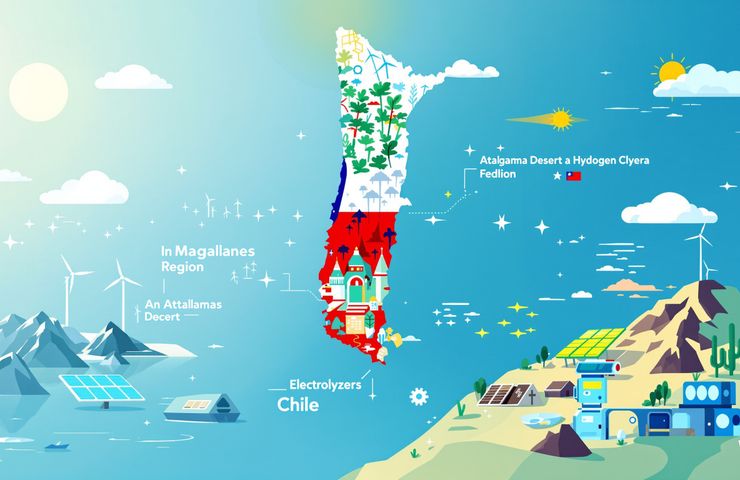
Green Hydrogen Bill Lights Path for Chile’s Clean Energy Future
October 10, 2025Ever thought a desert and a fjord could team up to power our world? Chile is doing just that, leaning on its sun-drenched north and wind-whipped south to champion green hydrogen. A fresh piece of legislation just cruised through the congressional finance committee, and it’s about to land in the Chamber of Deputies. The Green Hydrogen Industry Promotion Bill proposes USD 2.8 billion in tax credits—an ambitious push to slash emissions by 64% and ditch 98% of the country’s fossil fuel habit.
Back in August 2025, the Finance Ministry under Mario Marcel, Energy led by Diego Pardow, and the Economy team with Nicolás Grau joined forces to roll out this plan. Instead of throwing money at producers, they’re putting a demand-side spin on it. Companies that buy green hydrogen and its derivatives—think ammonia and methanol—from local suppliers can knock down their corporate tax bills. From 2025 to 2030, an Interministerial Committee for Green Hydrogen will host six competitive tenders. They’ll dish out the biggest credits early on, then dial them back as the market matures. And for those setting up shop in the Magallanes Region or Chilean Antarctica, there’s a sweet deal: exemptions from First Category Tax and VAT on imported capital goods, in exchange for reinvesting in regional development.
Historical Path to the Bill
Chile’s journey into the world of sustainable energy kicked off in November 2020 with the National Green Hydrogen Strategy. The goal? Hit 5 GW of renewable capacity by 2025 and ramp up to a whopping 300 GW by 2050. Then, in December 2021, the first funding round backed Enel Green Power Chile and Highly Innovative Fuels with CLP 16.9 million to set up about 240 MW of electrolyzers. In 2024, the Green Hydrogen Action Plan 2023–2030 fine-tuned policy levers and ironed out environmental reviews. By May 2025, a presidential order sped up permits and unified criteria for environmental impact—essentially laying the rails for this big tax-credit move.
The Renewable Powerhouse
Believe it or not, Chile sits on roughly 2,000 GW of renewable potential—about 80 times its current installations. In the Atacama Desert, solar panels feast on some of the highest irradiation levels on Earth. Head south to Patagonia, and gusty winds spin turbines into reliable powerhouses. According to the International Energy Agency, Chile could crank out 160 million tonnes of green hydrogen every year, with levelized costs dropping to USD 0.8/kg in the north and USD 1.0/kg in the south by 2030. It’s like having two natural batteries, one baked by the sun and the other charged by the wind.
Electrolysis at the Heart
At the center of all this is electrolysis: splitting water into hydrogen and oxygen using clean energy. There are different electrolyzer flavors—alkaline, PEM, solid oxide—each with its own pros and cons. Rather than handing out production subsidies, the bill nudges companies to build the entire value chain, from solar farms to storage tanks, right through to conversion hubs churning out ammonia and methanol. Picture a high-tech orchestra of panels, turbines, and machines all tuned to the same eco-friendly symphony.
Economic and Environmental Stakes
This legislation goes beyond cutting carbon; it’s about reshaping an economy. If even a third to half of the submitted projects get off the ground, Chile’s green hydrogen export market might balloon to USD 24 billion by 2050. That’s enough to rival the country’s storied mining sector. A budding ecosystem of engineering firms, electrolyzer manufacturers, and environmental consultants is already forming, promising thousands of new jobs. But let’s not ignore the water issue: NGOs warn that large-scale hydrogen production could strain local supplies, especially up north. Magallanes has more water, but at least one project has hit the brakes over community concerns. It’s a reminder that social buy-in is as critical as financial backing when aiming for true industrial decarbonization.
Challenges and Trade-offs
No policy is a magic wand. Interest in global green hydrogen has cooled a bit, and initial projects often spend USD 20–30 million a year on Environmental Impact Assessments alone. The bill’s tapering credit caps spark a race for early movers—great if you’re first in line, tougher if you’re late to the party. On the permitting front, a separate bill aims to chop environmental review times by 30–70%, but it’s still waiting on the finish line. Focusing incentives on buyers is a clever market-pull strategy, but it hinges on off-take agreements actually happening—otherwise you might feel like you’re pushing a boulder uphill.
Global Competitiveness and Market Dynamics
While the local scene heats up, the big win is in exports. Economies like Japan and Germany are lining up for clean ammonia and hydrogen imports to meet their tough decarbonization targets. With its projected low-cost supply, Chile could undercut players from Australia or the Middle East—if it nails logistics. That means building out shipping terminals, ammonia-fueled tankers, and cracking facilities abroad. Trade deals, port capacity, and insurance frameworks are as vital as the wind turbines and electrolyzers at home. In many ways, those early tenders telegraph to investors that Chile means business on the global sustainable energy stage.
A Forward Look
So what’s next? The Chamber of Deputies vote will be a big litmus test for political resolve. If it clears that hurdle, expect the first tender to spark in early 2026. Beyond Chile’s borders, this could inspire other nations to try demand-side carrots instead of traditional supply-side sticks. As wind farms hum in Magallanes and electrolyzers click to life, the deserts and fjords might just become the launchpad for a truly zero-emission revolution in hydrogen production.
Chile’s green hydrogen experiment isn’t just another policy paper—it’s a real-world collision of resources, regulations, and markets. Feel that buzz in the air? If the bill sails through, Patagonia’s winds will be doing more than roaring through mountains. They’ll be priming the pipes of a new energy era.
Stay tuned for that vote—the winds of change are truly picking up speed.



 With over 15 years of reporting hydrogen news, we are your premier source for the latest updates and insights in hydrogen and renewable energy.
With over 15 years of reporting hydrogen news, we are your premier source for the latest updates and insights in hydrogen and renewable energy.